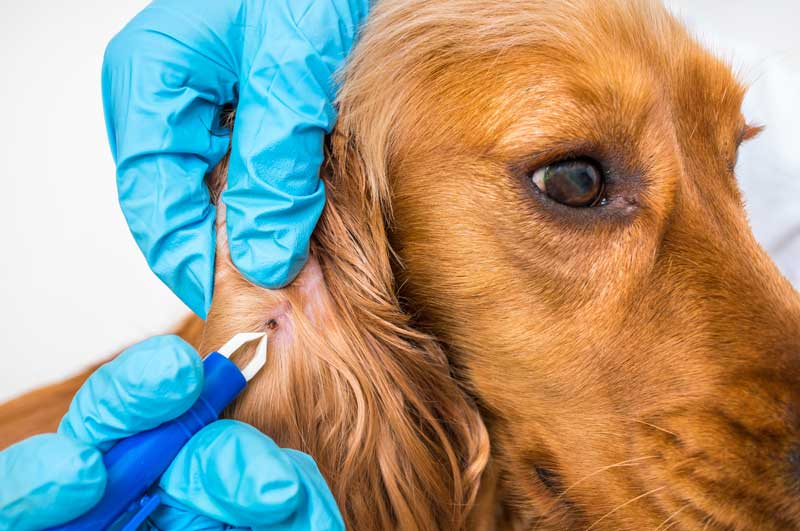Blog Post

As Spring Rolls in, Protect Your Dog From Lyme Disease
- By
- •
- 05 Jun, 2018

Lyme disease is a difficult-to-treat bacterial infection caused by the bacterium Borrelia burgdorferi. Transmissible to dogs, humans, and an array of other mammals, it becomes more common in springtime when the ticks that spread the disease are more active.
Lyme disease is not as common in Florida as it is in the Mid-Atlantic states, but Floridians should still take action to protect their dogs from the Lyme disease, especially in the spring.
The following are four key ways dog owners can protect their pets from Lyme disease.
1. Keep Your Yard Well-Maintained
Ticks tend to gather in tall grass, especially when that grass is littered with leaf debris and lawn clippings. They also enjoy shade, such as that provided in a wood pile or a pile of leaves. To decrease the chances of your dog picking up ticks when he or she roams outside, follow these steps to keep your yard as tidy as possible:
- Mow your lawn often so the grass does not get too long.
- Promptly clean up any leftover fall leaves in the spring.
- Keep bushes trimmed, and remove debris from beneath them.
- Neatly stack firewood, preferably not against a building.
- Use a weed whacker to regularly trim back weeds and tall grass along fence lines.
If you live on a large expanse of land and cannot manage to keep all of it trimmed and maintained, consider fencing off just a portion of land for your dog to use, rather than allowing him or her to wander into the untrimmed areas where ticks may be present.
2. Check for Ticks After Going off Property
If you take your dog off the property for walks, especially in wooded areas or fields with tall grass, make sure you check over his or her entire body when you return. Remember that young ticks can be very small - the size of a pinhead.
It takes a tick at least several hours to transmit Lyme disease to a dog, so if you remove a tick promptly, the risk is minimized. To remove a tick, use a pair of tweezers with a pointed tip. Spread your dog's fur to expose the tick, and grasp the tick right next to the skin. Pull it away with a steady motion; do not twist the tweezers.
After you've removed the tick, apply some rubbing alcohol to the bite, and also use the alcohol to sanitize the tweezers. Then wash your hands.
3. Use a Flea-and-Tick Preventative Medication
As spring rolls in, make sure your dog is on a good-quality flea-and-tick preventative medication. Several vet-recommended treatments are available that you can apply to the back of your dog's neck once a month to repel ticks and fleas. For dogs who are sensitive to topical medications, use oral repellents instead.
While very effective, flea-and-tick preventatives are not 100 percent effective, so make sure you still follow the other tips discussed in this article - even when your dog is up-to-date on tick prevention medications.
While very effective, flea-and-tick preventatives are not 100 percent effective, so make sure you still follow the other tips discussed in this article - even when your dog is up-to-date on tick prevention medications.
4. Consider the Lyme Disease Vaccine
A canine vaccine for Lyme disease is available. It is not recommended for all dogs in Florida since Lyme disease is not terribly common in Florida. However, if you take your dog hiking in the woods a lot or you often travel out of state with your dog, you should talk to your vet about the Lyme disease vaccine. It can give you peace of mind if your dog is at a higher risk of a tick bite.
Lyme disease is a serious illness that causes fever, lethargy, and painful joints. Although treatable, it can become chronic, meaning that a dog will continue to suffer from flare-ups for the rest of his or her life. Take action to guard against tick bites and Lyme disease this spring. If you're looking for a vet in the Ponte Vedra Beach, St. Johns County, or Nocatee areas, contact Hirsch Animal Hospital.
LOCATION
Hirsch Animal Hospital
220 Valley Circle | Suite 101
Ponte Vedra Beach, FL 32082
Phone:
904-285-0023
Email:
hirschvet@gmail.com
BUSINESS HOURS
Business Hours:
Monday-Friday, 8 a.m.-6 p.m.
Saturday, 8 a.m.-1 p.m.
PAYMENT



LOCATION
Hirsch Animal Hospital
220 Valley Circle | Suite 101
Ponte Vedra Beach, FL 32082
Phone:
904-285-0023
Email:
hirschvet@gmail.com
BUSINESS HOURS
Business Hours:
Monday-Friday, 8 a.m.-6 p.m.
Saturday, 8 a.m.-1 p.m.
PAYMENT



SOCIAL
Share
Tweet
Share
Mail
Content, including images, displayed on this website is protected by copyright laws. Downloading, republication, retransmission or reproduction of content on this website is strictly prohibited. Terms of Use
| Privacy Policy
Content, including images, displayed on this website is protected by copyright laws. Downloading, republication, retransmission or reproduction of content on this website is strictly prohibited. Terms of Use
| Privacy Policy
Content, including images, displayed on this website is protected by copyright laws. Downloading, republication, retransmission or reproduction of content on this website is strictly prohibited. Terms of Use
| Privacy Policy
